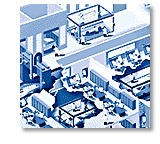

-
And yes, the thinking that led to the Design Machine – dearly desired by Nuccio Bertone in order to highlight his company’s continual adoption of the latest computerised design techniques and the automatic milling of models – is not so far removed from that of the incubator in the technology park. The concept of an integrated work process is the same, albeit distributed, for historical and logistical reasons, across various operational centres. At Caprie, Stile Bertone is dedicated to stylistic research, engineering feasibility and model and prototype construction.At Turin, Tecnodesign is concerned with product and process engineering up to the production level. At Grugliasco, Carrozzeria Bertone has experimental laboratories and a prototype construction unit that complements the existing structures at Caprie. Thus the design process of a new car can be developed through each logical stage using in-house resourses and project management techniques aimed at reducing the development times. Comprehensively, the Design Machine currently employs around 200 experienced personnel with whom the Customer-Manufacturer can develop new products in full freedom. Feasibility is guaranteed by its being not only a design centre, but also a production plant with ISO 9001 certification (the only one in Italy).
Design Machine is the expression of modern structures conceived and realised in order to guarantee maximum confidentiality and versatility. Offices, studios and workshops are located in areas divided by sliding partitions, opened and closed using electronic smart cards, similar to credit cards. The reason why is simple: at Design Machine confidentiality reigns supreme. Different customers, possibly guests at the same time, wish to keep the work under way a secret. And, without authorisation, not even the Bertone staff have unimpeded access to these areas. This solution enables the makers to participate personally in the project, directly following up all the phases that lead to the birth of a new model.
Part of the Design Machine structure can be assigned to the customer’s own personnel for a given period of time. But normally the Design Machine works to a brief supplied by the customer. In this case, it provides a team of specialists with impressive work experience in styling, product and process design as well as awareness of technologies and the possibilities offered by new materials to provide comprehensive coverage of the design process for a new car. The new sections offer autonomous modelling studios with the equipment necessary to develop models and internal links to the office areas above, a truly independent ‘box’ system that represents a concrete solution to the confidentiality issue and offers the customer the opportunity of co-locating his own resident engineers, something more and more frequently requested on large-scale projects.
The corollary to this ‘design box’ system is that the other centralised services, such as CAM-controlled 5-axis milling, panelbeating, painting, finishing and upholstery can all be exploited. To the visitor, the architectural and logistic setup looks very much the fruit of experience and suggests interesting possibilities for what is nowadays known as ‘On Job Training’, a service that is being increasingly requested by developing countries that have only recently embarked upon the car-design path (thoughts turn immediately to China, for example), providing areas dedicated to the operational training of foreign technicians in top know-how skills during the entire period of design development.
“Of course,” continues Piatti, “in the range of services offered by Design Machine, absolute confidentiality is a constant: we can supply dedicated consultancy services without even revealing the Bertone name, if that’s what a customer wants. Moreover, the Design Machine also covers all those areas of activity considered complementary to the design of a new car, which in reality are indispensable to its development. Take for example the construction of running prototypes already being built on semi-definitive tooling.”
And as for industrial design, the Design Machine has developed its own design criteria in order to cover the entire range of activities demanded by the gestation of a new product. The Bertone style centre has always believed that only total independence from other industrial groups and the reality of being put to the test in different areas represents the right path for a modern, evolved design house to take, attributing the design term with the full significance of a global project. “Feasibility and appeal,” says Piatti, “are the major concerns of design.
The designer’s work is to elaborate ideas and translate them into hard facts. In this sense, automotive know-how still has a lot to say in terms of style, engineering, ergonomics, functionality and the use of alternative materials to create an end product that isn’t born in the dexterity or intuition of an isolated genius, but which, on the contrary, is the logical outcome of a team effort that also takes into consideration the process, the feasibility studies, the prototype experiments and the awareness of leading-edge technologies such as CAD, CAS and CAM. “Industrial design currently represents around 5 percent of Design Machine turnover.
A percentage inevitably destined to rise and behind which lies a creative surge vital for our company. It’s a necessary complement so as not to restrict ourselves to a monoculture that looks exclusively to car design.” In terms of turnover and profits the results of the Design Machine, whose stock capital is wholly underwritten by the Bertone family, confirm the validity of the management formula it has adopted as much as the quality of the work produced in terms of styling, design techniques and technology. Turnover for 1997 is estimated at between 25 and 30 billion Lire.
The article continues in Auto & Design no. 103










